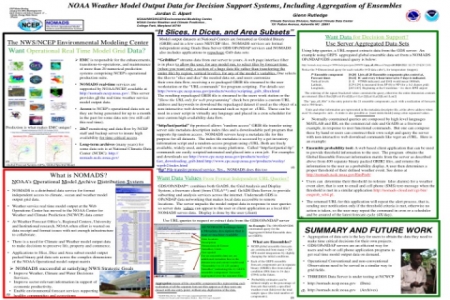The skill and accuracy of operational atmospheric forecasts from deterministic models have increased, and there are now ensembles of such models that yield a “cloud” of forecasts that provide statistics to improve decisions that protect life, property and commerce. The benefits of improved forecast predictions directly support decision makers for climate, energy, and water users as well as producers. Numerical weather model ensembles are constructed by changing initial conditions to make a cloud of forecasts that attempt to span the space of possible atmospheric realizations which can quantify not only the most likely forecast, but also the uncertainty. However, the ensemble run history has led to an unprecedented increase in data production and information content from higher resolution, multi-model output and secondary calculation products. One difficulty is to obtain the needed subset of information required to estimate the probability of events, and report this information. The calibration required to reliably estimate the probability of events, and honing of decision threshold adjustments (heavy rain, snow, heat waves, weather related traffic, fire weather, etc.) will reduce false alarms for decision makers. To meet the future needs of the ever-broadening user community, ever increasing high volume model outputs, and address these issues on a national and international basis, NOAA implemented the NOAA Operational Model Archive and Distribution System (NOMADS). NOMADS provides real-time and retrospective format independent access to climate, ocean and weather model data and delivers high availability content services as part of NOAA’s official real time data dissemination at the NOAA Center for Weather and Climate Prediction web operations center and the archive component at the National Climatic Data Center (NCDC) respectively. An important aspect of the server’s abilities is to aggregate the matrix of model output offering access to probability and calibrating information for real time decision making. The aggregation in the content server reports over ensemble component and forecast time in addition to the other data dimensions of vertical layers and position (Latitude/Longitude) for each variable. The unpacking, organization and reading of many binary packed files is accomplished most efficiently on the server side while weather element event probability calculations, incorporating thresholds for more accurate decision support, and display remain for the client (user). Our goal is to reduce uncertainty for variables of interest, e.g, agricultural importance and other discrete events. The weather service operational GFS model ensemble and short range ensemble forecasts can make skillful probability forecasts to alert users if and when their selected weather events will occur. A description of how this framework operates and how it can be implemented using existing NOMADS content services is described.


